Analyzing the Impact of Macro Environment on TESCO's Strategies
VerifiedAdded on 2023/01/12
|13
|4374
|1
AI Summary
This report analyzes the impact of macro environment on TESCO's strategies and evaluates its competitive position using frameworks like PESTLE analysis and Porter's Five Forces.
Contribute Materials
Your contribution can guide someone’s learning journey. Share your
documents today.

Business Strategy
Secure Best Marks with AI Grader
Need help grading? Try our AI Grader for instant feedback on your assignments.
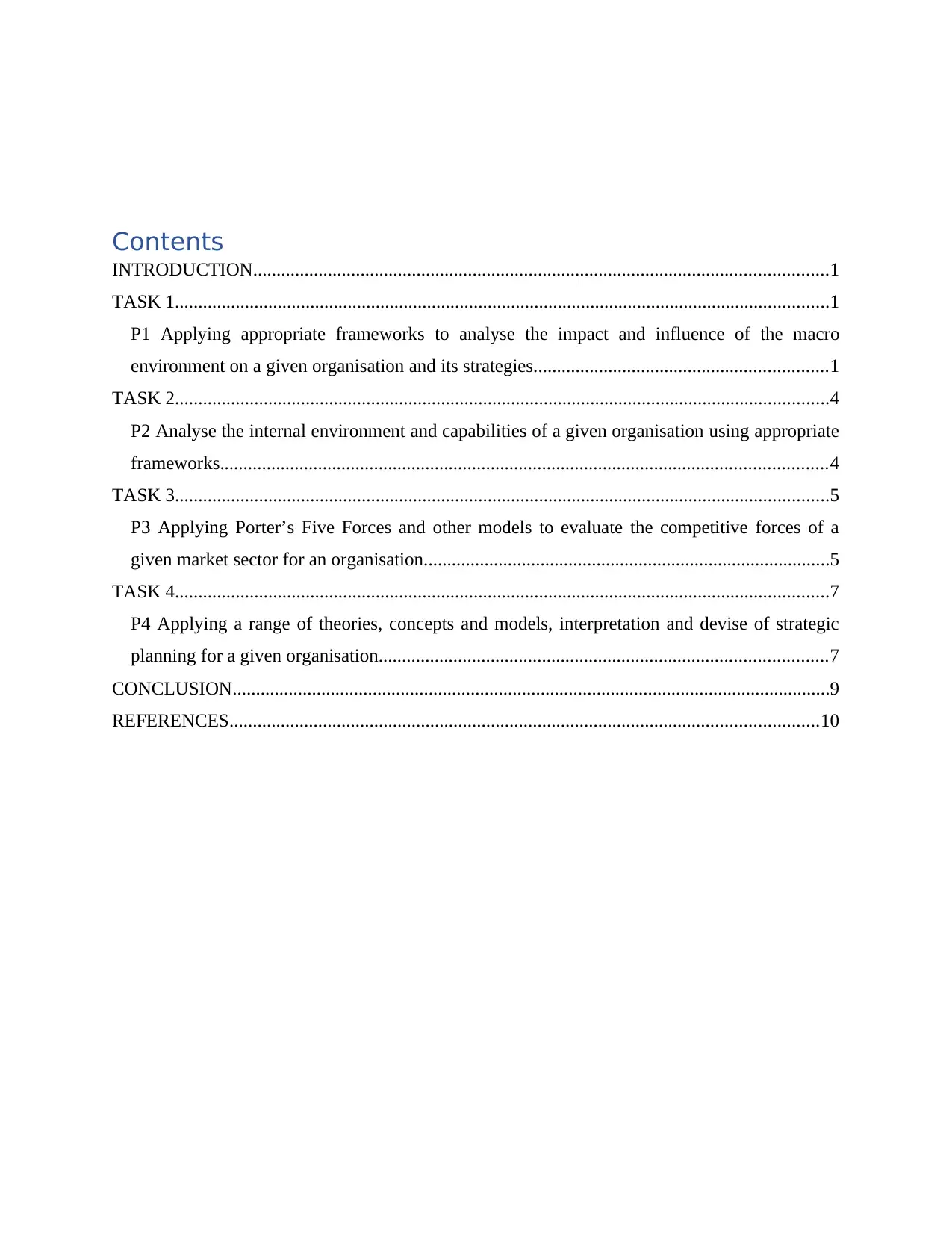
Contents
INTRODUCTION...........................................................................................................................1
TASK 1............................................................................................................................................1
P1 Applying appropriate frameworks to analyse the impact and influence of the macro
environment on a given organisation and its strategies...............................................................1
TASK 2............................................................................................................................................4
P2 Analyse the internal environment and capabilities of a given organisation using appropriate
frameworks..................................................................................................................................4
TASK 3............................................................................................................................................5
P3 Applying Porter’s Five Forces and other models to evaluate the competitive forces of a
given market sector for an organisation.......................................................................................5
TASK 4............................................................................................................................................7
P4 Applying a range of theories, concepts and models, interpretation and devise of strategic
planning for a given organisation................................................................................................7
CONCLUSION................................................................................................................................9
REFERENCES..............................................................................................................................10
INTRODUCTION...........................................................................................................................1
TASK 1............................................................................................................................................1
P1 Applying appropriate frameworks to analyse the impact and influence of the macro
environment on a given organisation and its strategies...............................................................1
TASK 2............................................................................................................................................4
P2 Analyse the internal environment and capabilities of a given organisation using appropriate
frameworks..................................................................................................................................4
TASK 3............................................................................................................................................5
P3 Applying Porter’s Five Forces and other models to evaluate the competitive forces of a
given market sector for an organisation.......................................................................................5
TASK 4............................................................................................................................................7
P4 Applying a range of theories, concepts and models, interpretation and devise of strategic
planning for a given organisation................................................................................................7
CONCLUSION................................................................................................................................9
REFERENCES..............................................................................................................................10
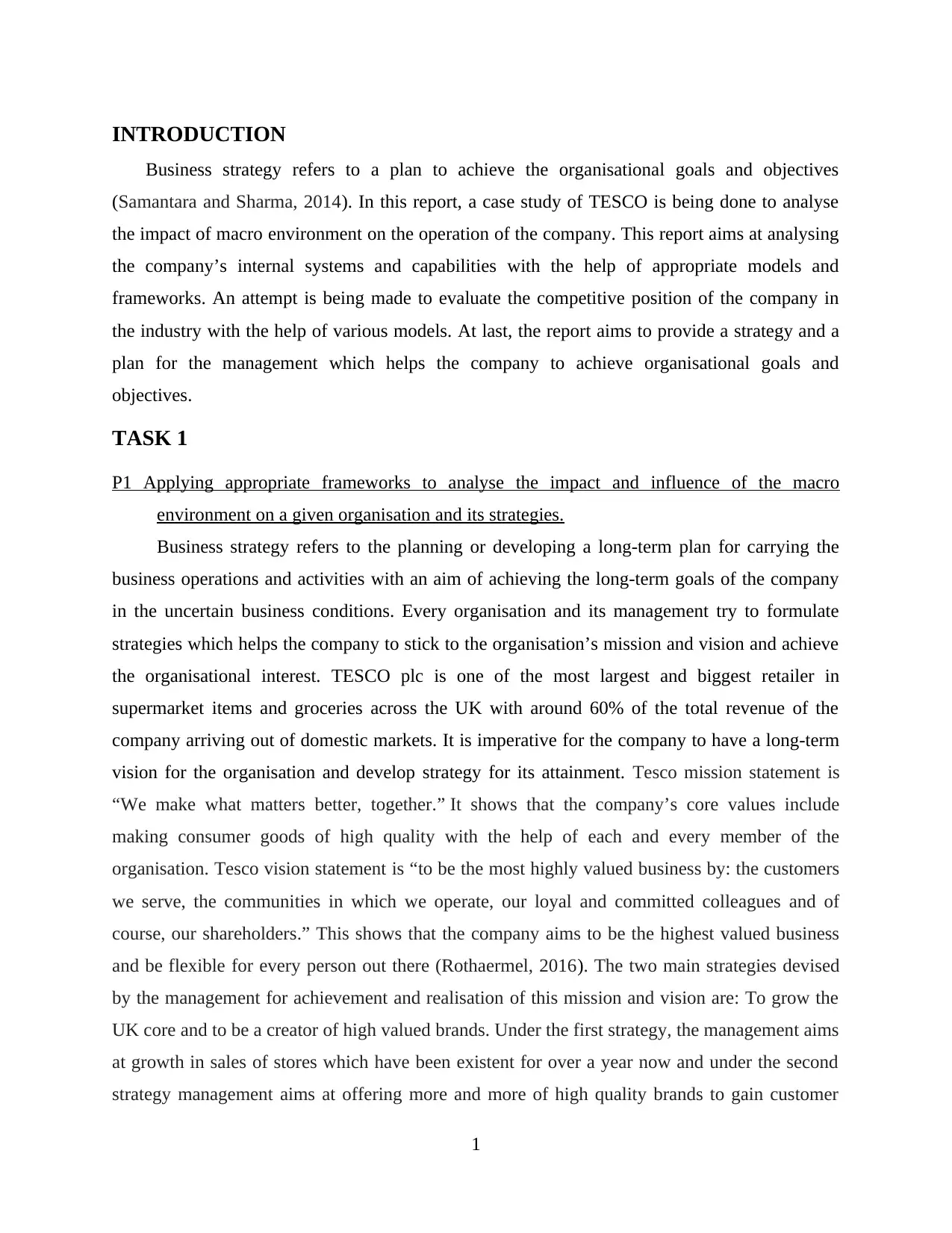
INTRODUCTION
Business strategy refers to a plan to achieve the organisational goals and objectives
(Samantara and Sharma, 2014). In this report, a case study of TESCO is being done to analyse
the impact of macro environment on the operation of the company. This report aims at analysing
the company’s internal systems and capabilities with the help of appropriate models and
frameworks. An attempt is being made to evaluate the competitive position of the company in
the industry with the help of various models. At last, the report aims to provide a strategy and a
plan for the management which helps the company to achieve organisational goals and
objectives.
TASK 1
P1 Applying appropriate frameworks to analyse the impact and influence of the macro
environment on a given organisation and its strategies.
Business strategy refers to the planning or developing a long-term plan for carrying the
business operations and activities with an aim of achieving the long-term goals of the company
in the uncertain business conditions. Every organisation and its management try to formulate
strategies which helps the company to stick to the organisation’s mission and vision and achieve
the organisational interest. TESCO plc is one of the most largest and biggest retailer in
supermarket items and groceries across the UK with around 60% of the total revenue of the
company arriving out of domestic markets. It is imperative for the company to have a long-term
vision for the organisation and develop strategy for its attainment. Tesco mission statement is
“We make what matters better, together.” It shows that the company’s core values include
making consumer goods of high quality with the help of each and every member of the
organisation. Tesco vision statement is “to be the most highly valued business by: the customers
we serve, the communities in which we operate, our loyal and committed colleagues and of
course, our shareholders.” This shows that the company aims to be the highest valued business
and be flexible for every person out there (Rothaermel, 2016). The two main strategies devised
by the management for achievement and realisation of this mission and vision are: To grow the
UK core and to be a creator of high valued brands. Under the first strategy, the management aims
at growth in sales of stores which have been existent for over a year now and under the second
strategy management aims at offering more and more of high quality brands to gain customer
1
Business strategy refers to a plan to achieve the organisational goals and objectives
(Samantara and Sharma, 2014). In this report, a case study of TESCO is being done to analyse
the impact of macro environment on the operation of the company. This report aims at analysing
the company’s internal systems and capabilities with the help of appropriate models and
frameworks. An attempt is being made to evaluate the competitive position of the company in
the industry with the help of various models. At last, the report aims to provide a strategy and a
plan for the management which helps the company to achieve organisational goals and
objectives.
TASK 1
P1 Applying appropriate frameworks to analyse the impact and influence of the macro
environment on a given organisation and its strategies.
Business strategy refers to the planning or developing a long-term plan for carrying the
business operations and activities with an aim of achieving the long-term goals of the company
in the uncertain business conditions. Every organisation and its management try to formulate
strategies which helps the company to stick to the organisation’s mission and vision and achieve
the organisational interest. TESCO plc is one of the most largest and biggest retailer in
supermarket items and groceries across the UK with around 60% of the total revenue of the
company arriving out of domestic markets. It is imperative for the company to have a long-term
vision for the organisation and develop strategy for its attainment. Tesco mission statement is
“We make what matters better, together.” It shows that the company’s core values include
making consumer goods of high quality with the help of each and every member of the
organisation. Tesco vision statement is “to be the most highly valued business by: the customers
we serve, the communities in which we operate, our loyal and committed colleagues and of
course, our shareholders.” This shows that the company aims to be the highest valued business
and be flexible for every person out there (Rothaermel, 2016). The two main strategies devised
by the management for achievement and realisation of this mission and vision are: To grow the
UK core and to be a creator of high valued brands. Under the first strategy, the management aims
at growth in sales of stores which have been existent for over a year now and under the second
strategy management aims at offering more and more of high quality brands to gain customer
1
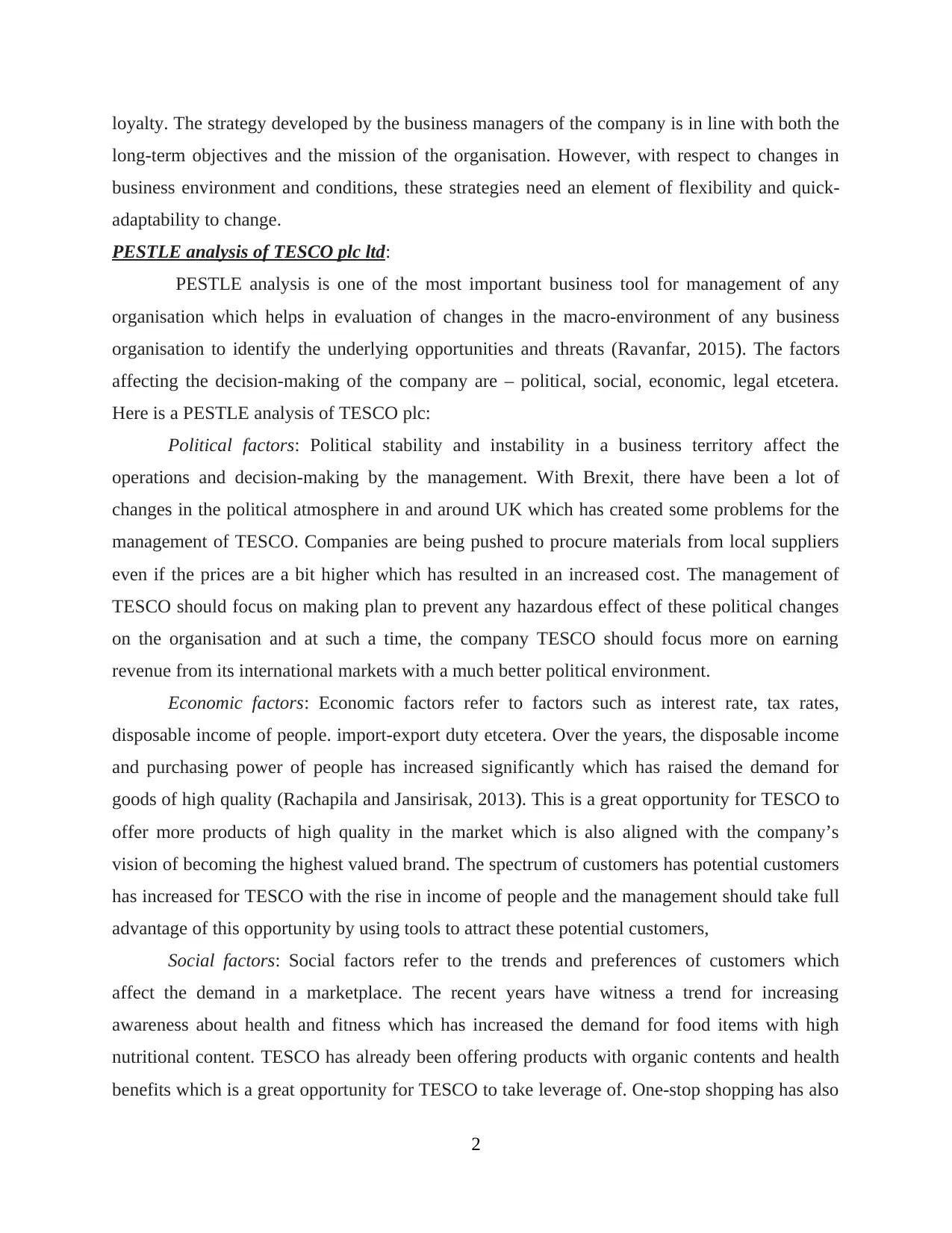
loyalty. The strategy developed by the business managers of the company is in line with both the
long-term objectives and the mission of the organisation. However, with respect to changes in
business environment and conditions, these strategies need an element of flexibility and quick-
adaptability to change.
PESTLE analysis of TESCO plc ltd:
PESTLE analysis is one of the most important business tool for management of any
organisation which helps in evaluation of changes in the macro-environment of any business
organisation to identify the underlying opportunities and threats (Ravanfar, 2015). The factors
affecting the decision-making of the company are – political, social, economic, legal etcetera.
Here is a PESTLE analysis of TESCO plc:
Political factors: Political stability and instability in a business territory affect the
operations and decision-making by the management. With Brexit, there have been a lot of
changes in the political atmosphere in and around UK which has created some problems for the
management of TESCO. Companies are being pushed to procure materials from local suppliers
even if the prices are a bit higher which has resulted in an increased cost. The management of
TESCO should focus on making plan to prevent any hazardous effect of these political changes
on the organisation and at such a time, the company TESCO should focus more on earning
revenue from its international markets with a much better political environment.
Economic factors: Economic factors refer to factors such as interest rate, tax rates,
disposable income of people. import-export duty etcetera. Over the years, the disposable income
and purchasing power of people has increased significantly which has raised the demand for
goods of high quality (Rachapila and Jansirisak, 2013). This is a great opportunity for TESCO to
offer more products of high quality in the market which is also aligned with the company’s
vision of becoming the highest valued brand. The spectrum of customers has potential customers
has increased for TESCO with the rise in income of people and the management should take full
advantage of this opportunity by using tools to attract these potential customers,
Social factors: Social factors refer to the trends and preferences of customers which
affect the demand in a marketplace. The recent years have witness a trend for increasing
awareness about health and fitness which has increased the demand for food items with high
nutritional content. TESCO has already been offering products with organic contents and health
benefits which is a great opportunity for TESCO to take leverage of. One-stop shopping has also
2
long-term objectives and the mission of the organisation. However, with respect to changes in
business environment and conditions, these strategies need an element of flexibility and quick-
adaptability to change.
PESTLE analysis of TESCO plc ltd:
PESTLE analysis is one of the most important business tool for management of any
organisation which helps in evaluation of changes in the macro-environment of any business
organisation to identify the underlying opportunities and threats (Ravanfar, 2015). The factors
affecting the decision-making of the company are – political, social, economic, legal etcetera.
Here is a PESTLE analysis of TESCO plc:
Political factors: Political stability and instability in a business territory affect the
operations and decision-making by the management. With Brexit, there have been a lot of
changes in the political atmosphere in and around UK which has created some problems for the
management of TESCO. Companies are being pushed to procure materials from local suppliers
even if the prices are a bit higher which has resulted in an increased cost. The management of
TESCO should focus on making plan to prevent any hazardous effect of these political changes
on the organisation and at such a time, the company TESCO should focus more on earning
revenue from its international markets with a much better political environment.
Economic factors: Economic factors refer to factors such as interest rate, tax rates,
disposable income of people. import-export duty etcetera. Over the years, the disposable income
and purchasing power of people has increased significantly which has raised the demand for
goods of high quality (Rachapila and Jansirisak, 2013). This is a great opportunity for TESCO to
offer more products of high quality in the market which is also aligned with the company’s
vision of becoming the highest valued brand. The spectrum of customers has potential customers
has increased for TESCO with the rise in income of people and the management should take full
advantage of this opportunity by using tools to attract these potential customers,
Social factors: Social factors refer to the trends and preferences of customers which
affect the demand in a marketplace. The recent years have witness a trend for increasing
awareness about health and fitness which has increased the demand for food items with high
nutritional content. TESCO has already been offering products with organic contents and health
benefits which is a great opportunity for TESCO to take leverage of. One-stop shopping has also
2
Secure Best Marks with AI Grader
Need help grading? Try our AI Grader for instant feedback on your assignments.

helped the management of TESCO to increase the sales of the company where the customers
complete requirements are met at a single place under one roof.
Technological factors: The rapid pace of technological development and advancements
has affected almost every industry in the world. This has opened up a new sales channel for
many companies which is online sales. TESCO went online way ahead of many of its
competitors and the increasing trend of buying things online at the convenience of a few clicks
with the help of technology is another great opportunity for company to increase revenue and
profits.
Legal factors: Legal factors refer to the laws, environmental laws, product safety laws,
labour laws etcetera. It is very difficult for the management of TESCO to understand the
implication of various rules and regulations and get the legal factor right since the company
operates in many countries around the globe and each country has its own set of rules and
regulations (Verbeke, 2013). The management should be aware of what is allowed and legal
within the territory it operates. The company has faced some lawsuits recently related to the
employee working conditions. It is very important for the organisation to employ a team of
considerable human resources for scanning the legal horizon and evaluating every aspect related
to the legal implications.
Environmental factors: Environmental factors refer to the elements related to ecological
imbalance and greenhouse gases emissions. This factor has come upfront in the last few years
which has put the onus on companies like TESCO to reduce their carbon footprints and
greenhouse emissions. Customers are generally ready to pay a slightly higher price for products
which are being manufactured after considering the impact on nature (Haddock-Millar and
Rigby, 2015). TESCO is one of the few companies which has adopted strategies to mitigate their
emissions and carbon footprints. The company has adopted major changes in distribution
network to improve its sustainability standing. The management should take advantage of the
early lead which the company has gained in the area of environmental protection and ecological
balance and increase the goodwill of the company.
3
complete requirements are met at a single place under one roof.
Technological factors: The rapid pace of technological development and advancements
has affected almost every industry in the world. This has opened up a new sales channel for
many companies which is online sales. TESCO went online way ahead of many of its
competitors and the increasing trend of buying things online at the convenience of a few clicks
with the help of technology is another great opportunity for company to increase revenue and
profits.
Legal factors: Legal factors refer to the laws, environmental laws, product safety laws,
labour laws etcetera. It is very difficult for the management of TESCO to understand the
implication of various rules and regulations and get the legal factor right since the company
operates in many countries around the globe and each country has its own set of rules and
regulations (Verbeke, 2013). The management should be aware of what is allowed and legal
within the territory it operates. The company has faced some lawsuits recently related to the
employee working conditions. It is very important for the organisation to employ a team of
considerable human resources for scanning the legal horizon and evaluating every aspect related
to the legal implications.
Environmental factors: Environmental factors refer to the elements related to ecological
imbalance and greenhouse gases emissions. This factor has come upfront in the last few years
which has put the onus on companies like TESCO to reduce their carbon footprints and
greenhouse emissions. Customers are generally ready to pay a slightly higher price for products
which are being manufactured after considering the impact on nature (Haddock-Millar and
Rigby, 2015). TESCO is one of the few companies which has adopted strategies to mitigate their
emissions and carbon footprints. The company has adopted major changes in distribution
network to improve its sustainability standing. The management should take advantage of the
early lead which the company has gained in the area of environmental protection and ecological
balance and increase the goodwill of the company.
3
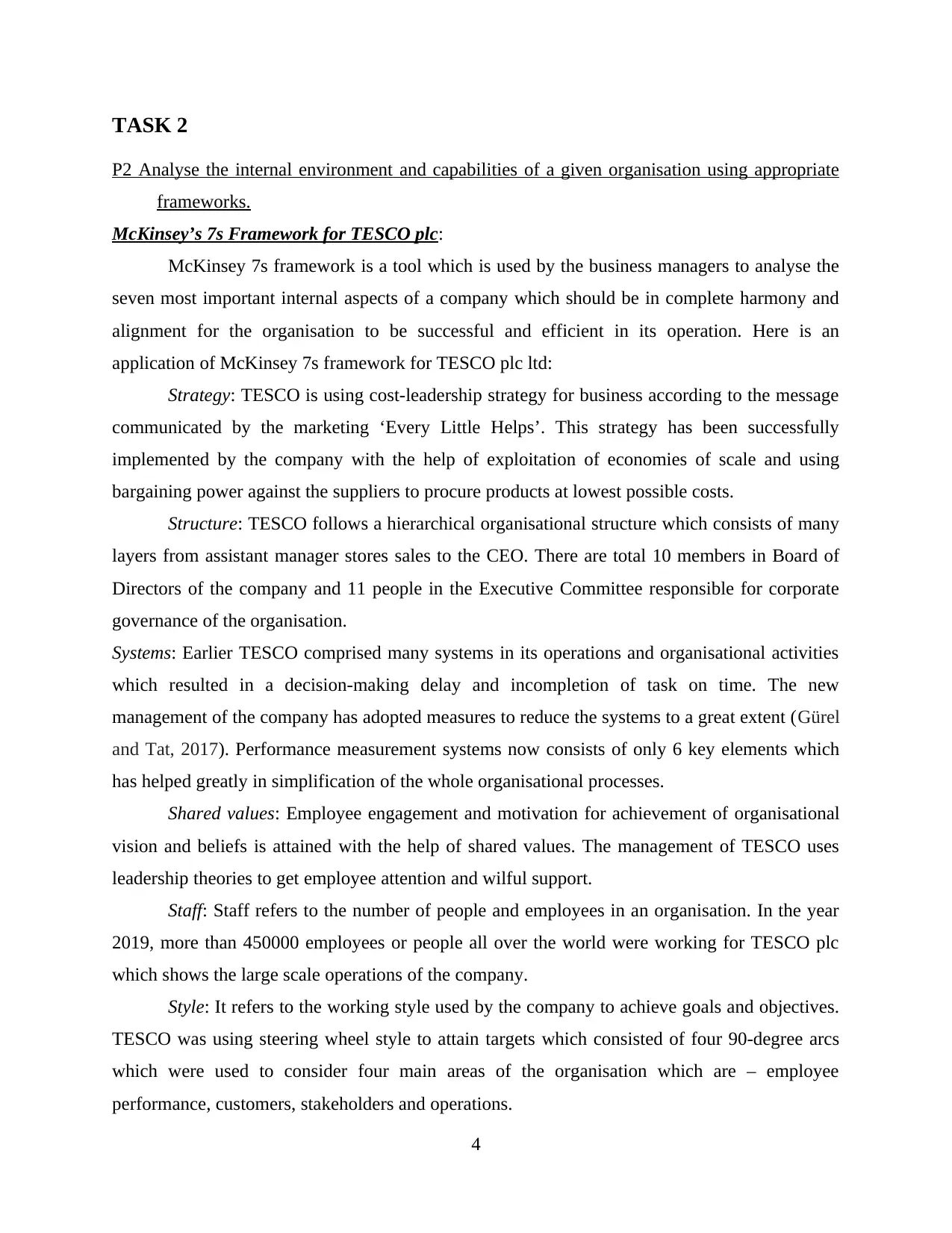
TASK 2
P2 Analyse the internal environment and capabilities of a given organisation using appropriate
frameworks.
McKinsey’s 7s Framework for TESCO plc:
McKinsey 7s framework is a tool which is used by the business managers to analyse the
seven most important internal aspects of a company which should be in complete harmony and
alignment for the organisation to be successful and efficient in its operation. Here is an
application of McKinsey 7s framework for TESCO plc ltd:
Strategy: TESCO is using cost-leadership strategy for business according to the message
communicated by the marketing ‘Every Little Helps’. This strategy has been successfully
implemented by the company with the help of exploitation of economies of scale and using
bargaining power against the suppliers to procure products at lowest possible costs.
Structure: TESCO follows a hierarchical organisational structure which consists of many
layers from assistant manager stores sales to the CEO. There are total 10 members in Board of
Directors of the company and 11 people in the Executive Committee responsible for corporate
governance of the organisation.
Systems: Earlier TESCO comprised many systems in its operations and organisational activities
which resulted in a decision-making delay and incompletion of task on time. The new
management of the company has adopted measures to reduce the systems to a great extent (Gürel
and Tat, 2017). Performance measurement systems now consists of only 6 key elements which
has helped greatly in simplification of the whole organisational processes.
Shared values: Employee engagement and motivation for achievement of organisational
vision and beliefs is attained with the help of shared values. The management of TESCO uses
leadership theories to get employee attention and wilful support.
Staff: Staff refers to the number of people and employees in an organisation. In the year
2019, more than 450000 employees or people all over the world were working for TESCO plc
which shows the large scale operations of the company.
Style: It refers to the working style used by the company to achieve goals and objectives.
TESCO was using steering wheel style to attain targets which consisted of four 90-degree arcs
which were used to consider four main areas of the organisation which are – employee
performance, customers, stakeholders and operations.
4
P2 Analyse the internal environment and capabilities of a given organisation using appropriate
frameworks.
McKinsey’s 7s Framework for TESCO plc:
McKinsey 7s framework is a tool which is used by the business managers to analyse the
seven most important internal aspects of a company which should be in complete harmony and
alignment for the organisation to be successful and efficient in its operation. Here is an
application of McKinsey 7s framework for TESCO plc ltd:
Strategy: TESCO is using cost-leadership strategy for business according to the message
communicated by the marketing ‘Every Little Helps’. This strategy has been successfully
implemented by the company with the help of exploitation of economies of scale and using
bargaining power against the suppliers to procure products at lowest possible costs.
Structure: TESCO follows a hierarchical organisational structure which consists of many
layers from assistant manager stores sales to the CEO. There are total 10 members in Board of
Directors of the company and 11 people in the Executive Committee responsible for corporate
governance of the organisation.
Systems: Earlier TESCO comprised many systems in its operations and organisational activities
which resulted in a decision-making delay and incompletion of task on time. The new
management of the company has adopted measures to reduce the systems to a great extent (Gürel
and Tat, 2017). Performance measurement systems now consists of only 6 key elements which
has helped greatly in simplification of the whole organisational processes.
Shared values: Employee engagement and motivation for achievement of organisational
vision and beliefs is attained with the help of shared values. The management of TESCO uses
leadership theories to get employee attention and wilful support.
Staff: Staff refers to the number of people and employees in an organisation. In the year
2019, more than 450000 employees or people all over the world were working for TESCO plc
which shows the large scale operations of the company.
Style: It refers to the working style used by the company to achieve goals and objectives.
TESCO was using steering wheel style to attain targets which consisted of four 90-degree arcs
which were used to consider four main areas of the organisation which are – employee
performance, customers, stakeholders and operations.
4
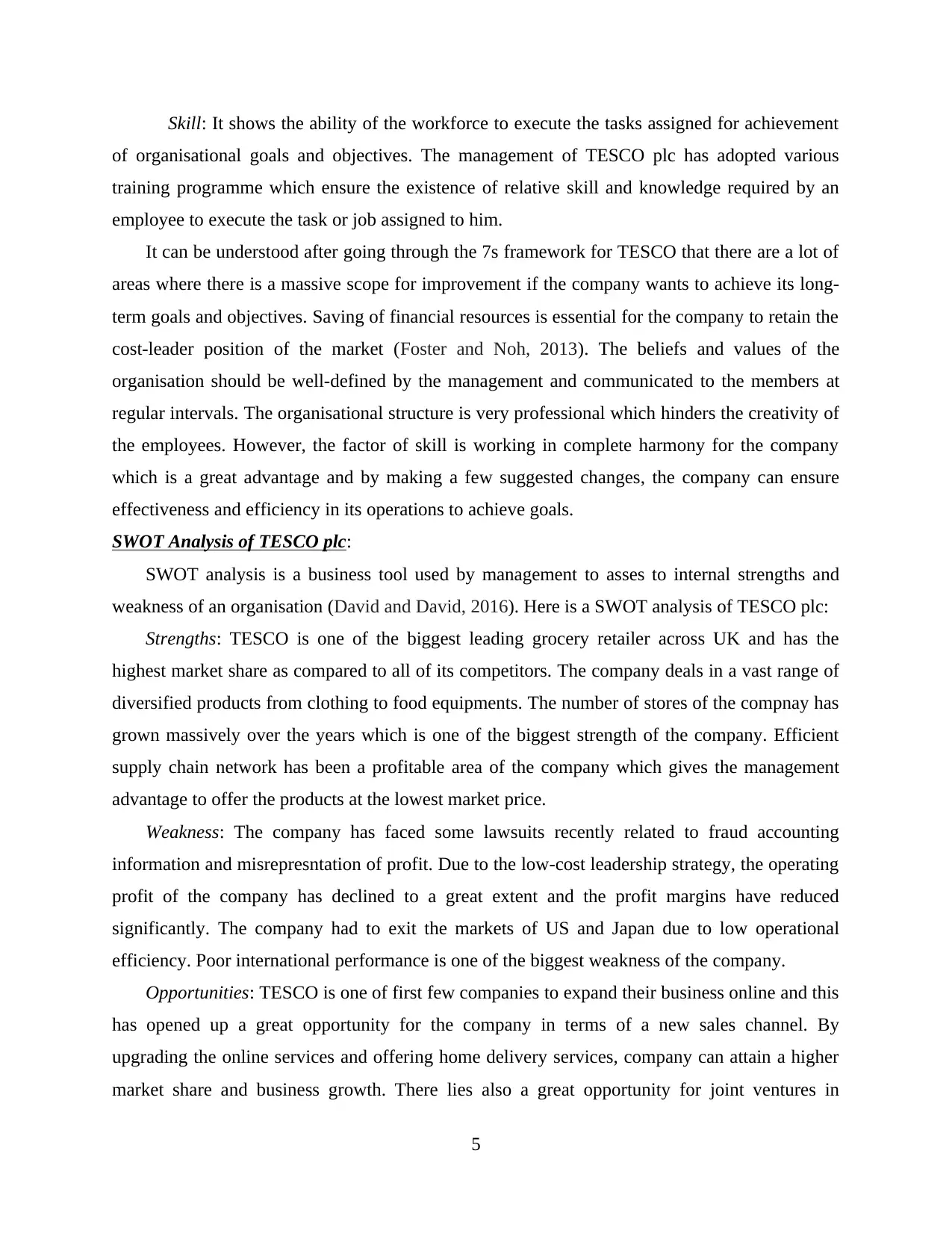
Skill: It shows the ability of the workforce to execute the tasks assigned for achievement
of organisational goals and objectives. The management of TESCO plc has adopted various
training programme which ensure the existence of relative skill and knowledge required by an
employee to execute the task or job assigned to him.
It can be understood after going through the 7s framework for TESCO that there are a lot of
areas where there is a massive scope for improvement if the company wants to achieve its long-
term goals and objectives. Saving of financial resources is essential for the company to retain the
cost-leader position of the market (Foster and Noh, 2013). The beliefs and values of the
organisation should be well-defined by the management and communicated to the members at
regular intervals. The organisational structure is very professional which hinders the creativity of
the employees. However, the factor of skill is working in complete harmony for the company
which is a great advantage and by making a few suggested changes, the company can ensure
effectiveness and efficiency in its operations to achieve goals.
SWOT Analysis of TESCO plc:
SWOT analysis is a business tool used by management to asses to internal strengths and
weakness of an organisation (David and David, 2016). Here is a SWOT analysis of TESCO plc:
Strengths: TESCO is one of the biggest leading grocery retailer across UK and has the
highest market share as compared to all of its competitors. The company deals in a vast range of
diversified products from clothing to food equipments. The number of stores of the compnay has
grown massively over the years which is one of the biggest strength of the company. Efficient
supply chain network has been a profitable area of the company which gives the management
advantage to offer the products at the lowest market price.
Weakness: The company has faced some lawsuits recently related to fraud accounting
information and misrepresntation of profit. Due to the low-cost leadership strategy, the operating
profit of the company has declined to a great extent and the profit margins have reduced
significantly. The company had to exit the markets of US and Japan due to low operational
efficiency. Poor international performance is one of the biggest weakness of the company.
Opportunities: TESCO is one of first few companies to expand their business online and this
has opened up a great opportunity for the company in terms of a new sales channel. By
upgrading the online services and offering home delivery services, company can attain a higher
market share and business growth. There lies also a great opportunity for joint ventures in
5
of organisational goals and objectives. The management of TESCO plc has adopted various
training programme which ensure the existence of relative skill and knowledge required by an
employee to execute the task or job assigned to him.
It can be understood after going through the 7s framework for TESCO that there are a lot of
areas where there is a massive scope for improvement if the company wants to achieve its long-
term goals and objectives. Saving of financial resources is essential for the company to retain the
cost-leader position of the market (Foster and Noh, 2013). The beliefs and values of the
organisation should be well-defined by the management and communicated to the members at
regular intervals. The organisational structure is very professional which hinders the creativity of
the employees. However, the factor of skill is working in complete harmony for the company
which is a great advantage and by making a few suggested changes, the company can ensure
effectiveness and efficiency in its operations to achieve goals.
SWOT Analysis of TESCO plc:
SWOT analysis is a business tool used by management to asses to internal strengths and
weakness of an organisation (David and David, 2016). Here is a SWOT analysis of TESCO plc:
Strengths: TESCO is one of the biggest leading grocery retailer across UK and has the
highest market share as compared to all of its competitors. The company deals in a vast range of
diversified products from clothing to food equipments. The number of stores of the compnay has
grown massively over the years which is one of the biggest strength of the company. Efficient
supply chain network has been a profitable area of the company which gives the management
advantage to offer the products at the lowest market price.
Weakness: The company has faced some lawsuits recently related to fraud accounting
information and misrepresntation of profit. Due to the low-cost leadership strategy, the operating
profit of the company has declined to a great extent and the profit margins have reduced
significantly. The company had to exit the markets of US and Japan due to low operational
efficiency. Poor international performance is one of the biggest weakness of the company.
Opportunities: TESCO is one of first few companies to expand their business online and this
has opened up a great opportunity for the company in terms of a new sales channel. By
upgrading the online services and offering home delivery services, company can attain a higher
market share and business growth. There lies also a great opportunity for joint ventures in
5
Paraphrase This Document
Need a fresh take? Get an instant paraphrase of this document with our AI Paraphraser
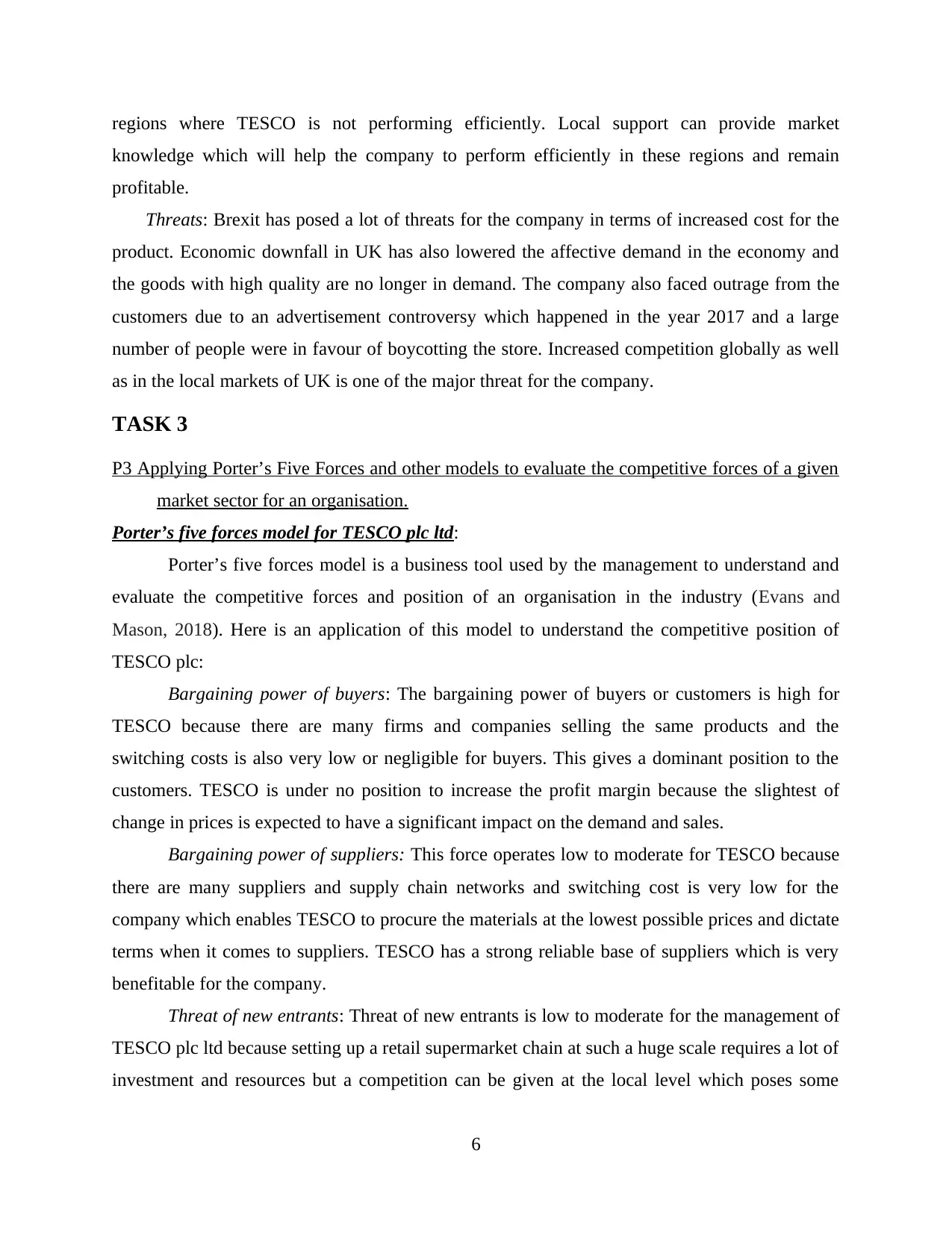
regions where TESCO is not performing efficiently. Local support can provide market
knowledge which will help the company to perform efficiently in these regions and remain
profitable.
Threats: Brexit has posed a lot of threats for the company in terms of increased cost for the
product. Economic downfall in UK has also lowered the affective demand in the economy and
the goods with high quality are no longer in demand. The company also faced outrage from the
customers due to an advertisement controversy which happened in the year 2017 and a large
number of people were in favour of boycotting the store. Increased competition globally as well
as in the local markets of UK is one of the major threat for the company.
TASK 3
P3 Applying Porter’s Five Forces and other models to evaluate the competitive forces of a given
market sector for an organisation.
Porter’s five forces model for TESCO plc ltd:
Porter’s five forces model is a business tool used by the management to understand and
evaluate the competitive forces and position of an organisation in the industry (Evans and
Mason, 2018). Here is an application of this model to understand the competitive position of
TESCO plc:
Bargaining power of buyers: The bargaining power of buyers or customers is high for
TESCO because there are many firms and companies selling the same products and the
switching costs is also very low or negligible for buyers. This gives a dominant position to the
customers. TESCO is under no position to increase the profit margin because the slightest of
change in prices is expected to have a significant impact on the demand and sales.
Bargaining power of suppliers: This force operates low to moderate for TESCO because
there are many suppliers and supply chain networks and switching cost is very low for the
company which enables TESCO to procure the materials at the lowest possible prices and dictate
terms when it comes to suppliers. TESCO has a strong reliable base of suppliers which is very
benefitable for the company.
Threat of new entrants: Threat of new entrants is low to moderate for the management of
TESCO plc ltd because setting up a retail supermarket chain at such a huge scale requires a lot of
investment and resources but a competition can be given at the local level which poses some
6
knowledge which will help the company to perform efficiently in these regions and remain
profitable.
Threats: Brexit has posed a lot of threats for the company in terms of increased cost for the
product. Economic downfall in UK has also lowered the affective demand in the economy and
the goods with high quality are no longer in demand. The company also faced outrage from the
customers due to an advertisement controversy which happened in the year 2017 and a large
number of people were in favour of boycotting the store. Increased competition globally as well
as in the local markets of UK is one of the major threat for the company.
TASK 3
P3 Applying Porter’s Five Forces and other models to evaluate the competitive forces of a given
market sector for an organisation.
Porter’s five forces model for TESCO plc ltd:
Porter’s five forces model is a business tool used by the management to understand and
evaluate the competitive forces and position of an organisation in the industry (Evans and
Mason, 2018). Here is an application of this model to understand the competitive position of
TESCO plc:
Bargaining power of buyers: The bargaining power of buyers or customers is high for
TESCO because there are many firms and companies selling the same products and the
switching costs is also very low or negligible for buyers. This gives a dominant position to the
customers. TESCO is under no position to increase the profit margin because the slightest of
change in prices is expected to have a significant impact on the demand and sales.
Bargaining power of suppliers: This force operates low to moderate for TESCO because
there are many suppliers and supply chain networks and switching cost is very low for the
company which enables TESCO to procure the materials at the lowest possible prices and dictate
terms when it comes to suppliers. TESCO has a strong reliable base of suppliers which is very
benefitable for the company.
Threat of new entrants: Threat of new entrants is low to moderate for the management of
TESCO plc ltd because setting up a retail supermarket chain at such a huge scale requires a lot of
investment and resources but a competition can be given at the local level which poses some
6
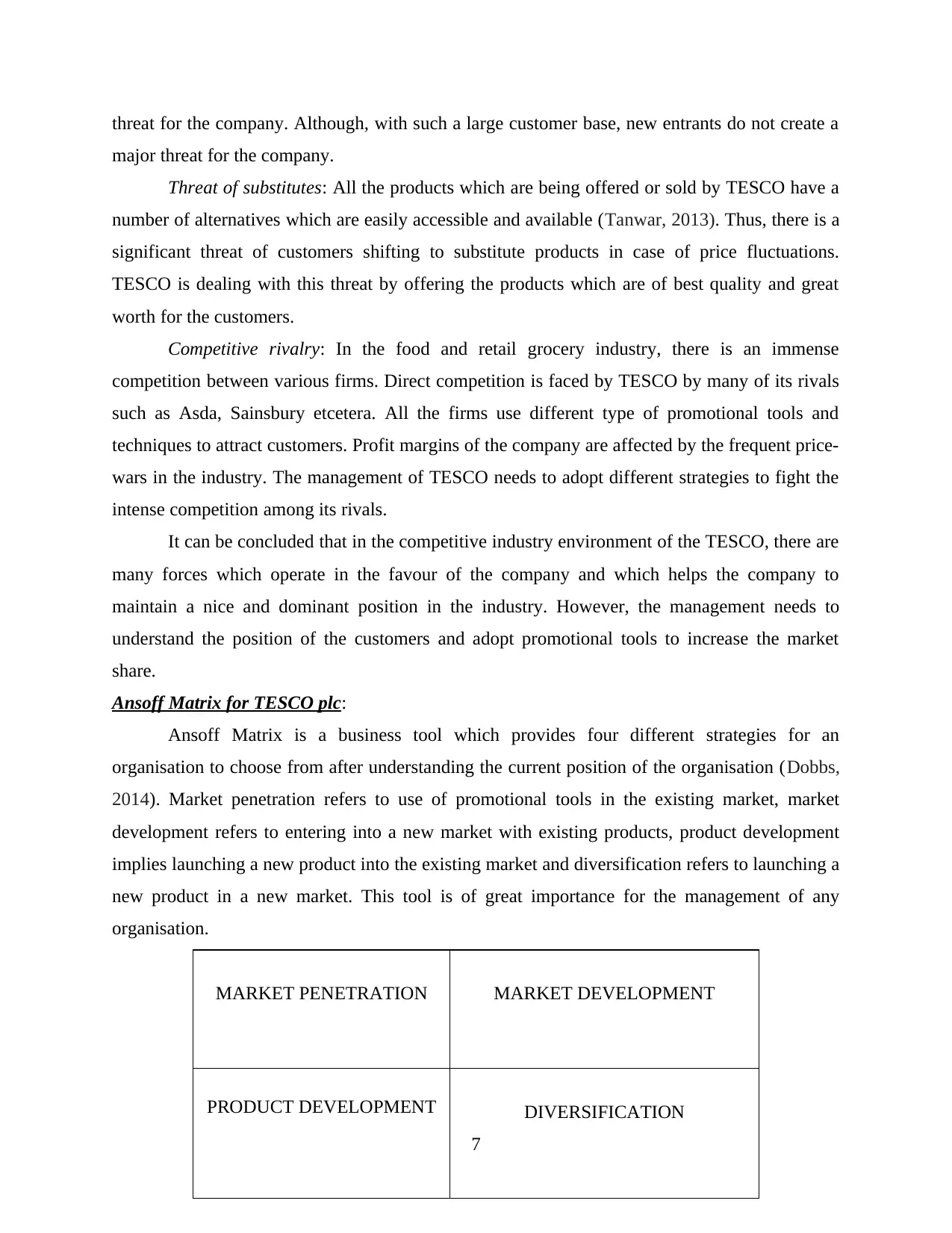
threat for the company. Although, with such a large customer base, new entrants do not create a
major threat for the company.
Threat of substitutes: All the products which are being offered or sold by TESCO have a
number of alternatives which are easily accessible and available (Tanwar, 2013). Thus, there is a
significant threat of customers shifting to substitute products in case of price fluctuations.
TESCO is dealing with this threat by offering the products which are of best quality and great
worth for the customers.
Competitive rivalry: In the food and retail grocery industry, there is an immense
competition between various firms. Direct competition is faced by TESCO by many of its rivals
such as Asda, Sainsbury etcetera. All the firms use different type of promotional tools and
techniques to attract customers. Profit margins of the company are affected by the frequent price-
wars in the industry. The management of TESCO needs to adopt different strategies to fight the
intense competition among its rivals.
It can be concluded that in the competitive industry environment of the TESCO, there are
many forces which operate in the favour of the company and which helps the company to
maintain a nice and dominant position in the industry. However, the management needs to
understand the position of the customers and adopt promotional tools to increase the market
share.
Ansoff Matrix for TESCO plc:
Ansoff Matrix is a business tool which provides four different strategies for an
organisation to choose from after understanding the current position of the organisation (Dobbs,
2014). Market penetration refers to use of promotional tools in the existing market, market
development refers to entering into a new market with existing products, product development
implies launching a new product into the existing market and diversification refers to launching a
new product in a new market. This tool is of great importance for the management of any
organisation.
7
MARKET PENETRATION MARKET DEVELOPMENT
PRODUCT DEVELOPMENT DIVERSIFICATION
major threat for the company.
Threat of substitutes: All the products which are being offered or sold by TESCO have a
number of alternatives which are easily accessible and available (Tanwar, 2013). Thus, there is a
significant threat of customers shifting to substitute products in case of price fluctuations.
TESCO is dealing with this threat by offering the products which are of best quality and great
worth for the customers.
Competitive rivalry: In the food and retail grocery industry, there is an immense
competition between various firms. Direct competition is faced by TESCO by many of its rivals
such as Asda, Sainsbury etcetera. All the firms use different type of promotional tools and
techniques to attract customers. Profit margins of the company are affected by the frequent price-
wars in the industry. The management of TESCO needs to adopt different strategies to fight the
intense competition among its rivals.
It can be concluded that in the competitive industry environment of the TESCO, there are
many forces which operate in the favour of the company and which helps the company to
maintain a nice and dominant position in the industry. However, the management needs to
understand the position of the customers and adopt promotional tools to increase the market
share.
Ansoff Matrix for TESCO plc:
Ansoff Matrix is a business tool which provides four different strategies for an
organisation to choose from after understanding the current position of the organisation (Dobbs,
2014). Market penetration refers to use of promotional tools in the existing market, market
development refers to entering into a new market with existing products, product development
implies launching a new product into the existing market and diversification refers to launching a
new product in a new market. This tool is of great importance for the management of any
organisation.
7
MARKET PENETRATION MARKET DEVELOPMENT
PRODUCT DEVELOPMENT DIVERSIFICATION

After considering the current position of TESCO plc, market penetration is not a huge
problem for the company since the company has enough resources and product range to offer
promotions and discounts within the existing market. Market development is also being followed
by the company properly, whenever there is an opportunity in the market for any new product,
the company exploits that for example the launch of organic products to increase and develop the
markets. TESCO has also entered into a lot of emerging market in the developing countries with
the existing product range. However, diversification is something which has a great scope and
potential for the company to further increase the market share and revenues.
TASK 4
P4 Applying a range of theories, concepts and models, interpretation and devise of strategic
planning for a given organisation.
Porter’s generic strategies for TESCO plc:
It is a framework which was developed by Michael Porter which shows or describes how
organisations can gain a competitive advantage by choosing or selecting right strategy for
business development (Channon and Caldart, 2015). The framework mainly focuses on three
strategies – cost-leadership strategy, differentiation strategy and focus strategy.
Cost-leadership strategy: It describes how companies can gain a market share by
lowering the costs of the product and offering discounts to attract more customers.
Differentiation strategy: It describes the strategy which involves how companies can
offer products which are different from the competitors are offering to gain a customer base and
increase the sales and revenue.
Focus strategy: It lays emphasis on using a focus strategy such as extensive marketing by
the companies to gain a competitive edge and market share.
In case of TESCO plc, it is recommend that the management should focus on cost-
leadership strategy for gaining a market share and becoming the highest valued brand of UK
domestic markets. Large scale operations of the company makes it possible to use economies of
scale and reduce cost of production and materials (Burns and Dewhurst, 2016). Effective use of
8
problem for the company since the company has enough resources and product range to offer
promotions and discounts within the existing market. Market development is also being followed
by the company properly, whenever there is an opportunity in the market for any new product,
the company exploits that for example the launch of organic products to increase and develop the
markets. TESCO has also entered into a lot of emerging market in the developing countries with
the existing product range. However, diversification is something which has a great scope and
potential for the company to further increase the market share and revenues.
TASK 4
P4 Applying a range of theories, concepts and models, interpretation and devise of strategic
planning for a given organisation.
Porter’s generic strategies for TESCO plc:
It is a framework which was developed by Michael Porter which shows or describes how
organisations can gain a competitive advantage by choosing or selecting right strategy for
business development (Channon and Caldart, 2015). The framework mainly focuses on three
strategies – cost-leadership strategy, differentiation strategy and focus strategy.
Cost-leadership strategy: It describes how companies can gain a market share by
lowering the costs of the product and offering discounts to attract more customers.
Differentiation strategy: It describes the strategy which involves how companies can
offer products which are different from the competitors are offering to gain a customer base and
increase the sales and revenue.
Focus strategy: It lays emphasis on using a focus strategy such as extensive marketing by
the companies to gain a competitive edge and market share.
In case of TESCO plc, it is recommend that the management should focus on cost-
leadership strategy for gaining a market share and becoming the highest valued brand of UK
domestic markets. Large scale operations of the company makes it possible to use economies of
scale and reduce cost of production and materials (Burns and Dewhurst, 2016). Effective use of
8
Secure Best Marks with AI Grader
Need help grading? Try our AI Grader for instant feedback on your assignments.
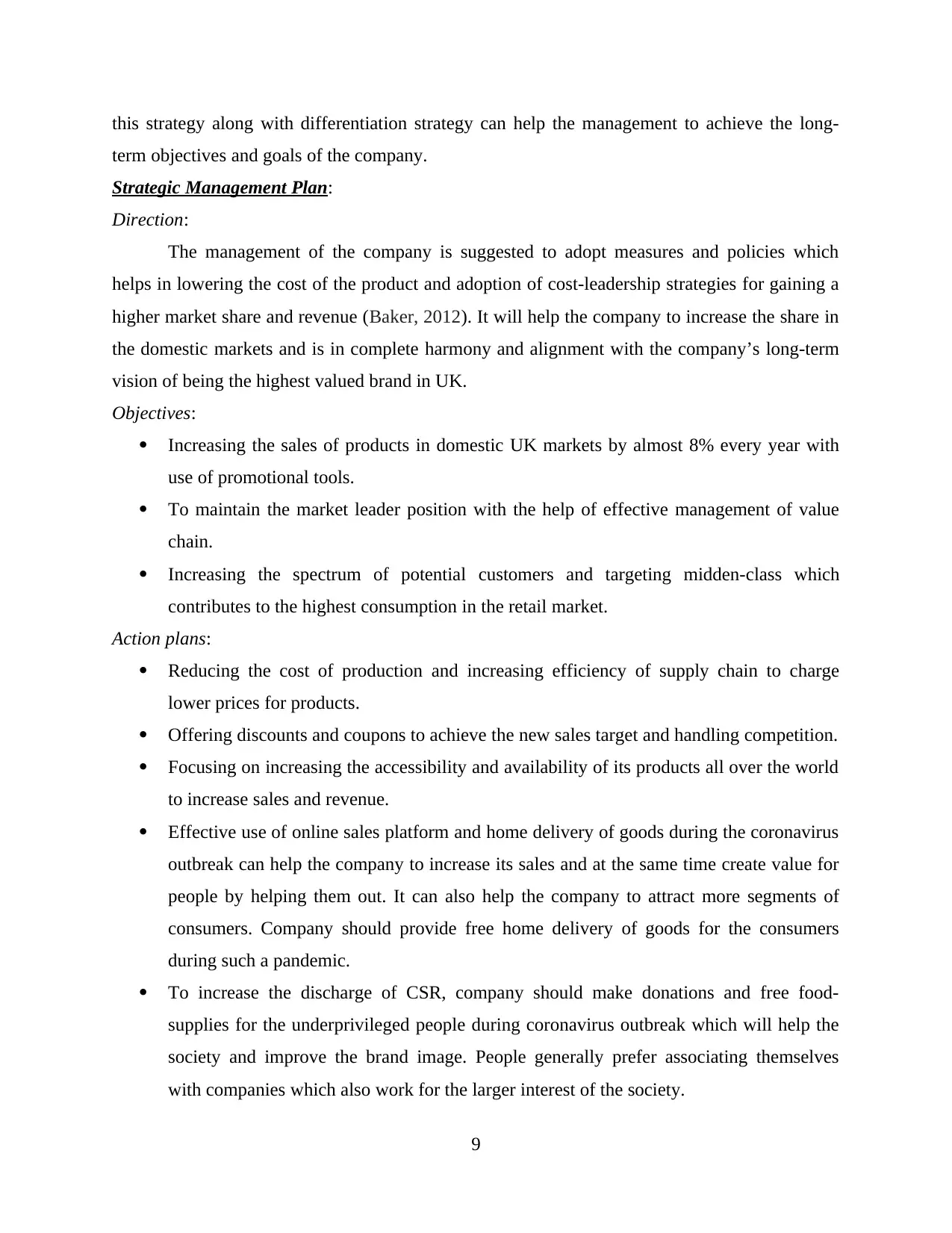
this strategy along with differentiation strategy can help the management to achieve the long-
term objectives and goals of the company.
Strategic Management Plan:
Direction:
The management of the company is suggested to adopt measures and policies which
helps in lowering the cost of the product and adoption of cost-leadership strategies for gaining a
higher market share and revenue (Baker, 2012). It will help the company to increase the share in
the domestic markets and is in complete harmony and alignment with the company’s long-term
vision of being the highest valued brand in UK.
Objectives:
Increasing the sales of products in domestic UK markets by almost 8% every year with
use of promotional tools.
To maintain the market leader position with the help of effective management of value
chain.
Increasing the spectrum of potential customers and targeting midden-class which
contributes to the highest consumption in the retail market.
Action plans:
Reducing the cost of production and increasing efficiency of supply chain to charge
lower prices for products.
Offering discounts and coupons to achieve the new sales target and handling competition.
Focusing on increasing the accessibility and availability of its products all over the world
to increase sales and revenue.
Effective use of online sales platform and home delivery of goods during the coronavirus
outbreak can help the company to increase its sales and at the same time create value for
people by helping them out. It can also help the company to attract more segments of
consumers. Company should provide free home delivery of goods for the consumers
during such a pandemic.
To increase the discharge of CSR, company should make donations and free food-
supplies for the underprivileged people during coronavirus outbreak which will help the
society and improve the brand image. People generally prefer associating themselves
with companies which also work for the larger interest of the society.
9
term objectives and goals of the company.
Strategic Management Plan:
Direction:
The management of the company is suggested to adopt measures and policies which
helps in lowering the cost of the product and adoption of cost-leadership strategies for gaining a
higher market share and revenue (Baker, 2012). It will help the company to increase the share in
the domestic markets and is in complete harmony and alignment with the company’s long-term
vision of being the highest valued brand in UK.
Objectives:
Increasing the sales of products in domestic UK markets by almost 8% every year with
use of promotional tools.
To maintain the market leader position with the help of effective management of value
chain.
Increasing the spectrum of potential customers and targeting midden-class which
contributes to the highest consumption in the retail market.
Action plans:
Reducing the cost of production and increasing efficiency of supply chain to charge
lower prices for products.
Offering discounts and coupons to achieve the new sales target and handling competition.
Focusing on increasing the accessibility and availability of its products all over the world
to increase sales and revenue.
Effective use of online sales platform and home delivery of goods during the coronavirus
outbreak can help the company to increase its sales and at the same time create value for
people by helping them out. It can also help the company to attract more segments of
consumers. Company should provide free home delivery of goods for the consumers
during such a pandemic.
To increase the discharge of CSR, company should make donations and free food-
supplies for the underprivileged people during coronavirus outbreak which will help the
society and improve the brand image. People generally prefer associating themselves
with companies which also work for the larger interest of the society.
9

This plan can be used by the management of the company which provides specific direction,
objectives and tactics to achieve and attain those objectives. Changes can be made with respect
to changing business conditions.
CONCLUSION
It can be concluded from the above report that business strategy is an important tool for
managers to achieve the organisational objectives. TESCO plc uses tools such as PESTLE
analysis to determine the impact of business environment on the decision making of the
company. A brief application of McKinsey’s 7s framework shows that the company is facing
some serious problems in terms of organisational structure and systems. The major strengths and
waekness of the company in terms of internal capabilities is being discussed in the report. It can
be concluded that TESCO maintains a strong competitive position in the industry after analysis
the market forces of competition (Abbott, 2015). The company makes efficient use of the
strategies described under Ansoff Matrix to increase the revenue and sales. At last, the report
provides a strategic management plan for the company to achieve its long term objectives after
analysis the impact of porter’s generic strategies with respect to company’s industrial position.
10
objectives and tactics to achieve and attain those objectives. Changes can be made with respect
to changing business conditions.
CONCLUSION
It can be concluded from the above report that business strategy is an important tool for
managers to achieve the organisational objectives. TESCO plc uses tools such as PESTLE
analysis to determine the impact of business environment on the decision making of the
company. A brief application of McKinsey’s 7s framework shows that the company is facing
some serious problems in terms of organisational structure and systems. The major strengths and
waekness of the company in terms of internal capabilities is being discussed in the report. It can
be concluded that TESCO maintains a strong competitive position in the industry after analysis
the market forces of competition (Abbott, 2015). The company makes efficient use of the
strategies described under Ansoff Matrix to increase the revenue and sales. At last, the report
provides a strategic management plan for the company to achieve its long term objectives after
analysis the impact of porter’s generic strategies with respect to company’s industrial position.
10

REFERENCES
Books and Journals
Abbott, R.J., 2015. Pestle Analysis for Students.
Baker, M., 2012. The marketing book. Routledge.
Burns, P. and Dewhurst, J. eds., 2016. Small business and entrepreneurship. Macmillan
International Higher Education.
Channon, D.F. and Caldart, A.A., 2015. McKinsey 7S model. Wiley encyclopedia of
management. pp.1-1.
David, F. and David, F.R., 2016. Strategic management: A competitive advantage approach,
concepts and cases. Pearson–Prentice Hall.
Dobbs, M.E., 2014. Guidelines for applying Porter's five forces framework: a set of industry
analysis templates. Competitiveness Review.
Evans, B. and Mason, R., 2018. The lean supply chain: managing the challenge at Tesco. Kogan
Page Publishers.
Foster, M.J. and Noh, T.J., 2013. Tesco strikes out into Asia. Frontiers of Business Research in
China. 7(2). pp.289-310.
Gürel, E. and Tat, M., 2017. SWOT analysis: a theoretical review. Journal of International
Social Research. 10(51).
Haddock-Millar, J. and Rigby, C., 2015. Business Strategy and the Environment: Tesco PLC’s
Declining Financial Performance and Underlying Issues. Review of Business & Finance
Studies. 6(3). pp.91-103.
Rachapila, T. and Jansirisak, S., 2013. Using Porter’s Five Forces Model for analysing the
competitive environment of Thailand’s sweet corn industry. International Journal of
Business and Social Research. 3(3). pp.174-184.
Ravanfar, M.M., 2015. Analyzing Organizational Structure based on 7s model of
McKinsey. Global Journal of Management And Business Research.
Rothaermel, F.T., 2016. Strategic management: concepts (Vol. 2). McGraw-Hill Education.
Samantara, R. and Sharma, N., 2014. Talent Management at Tesco HSC—A Case
Study. Management and Labour Studies. 39(4). pp.477-485.
Tanwar, R., 2013. Porter’s generic competitive strategies. Journal of business and
management. 15(1). pp.11-17.
Verbeke, A., 2013. International business strategy. Cambridge University Press.
11
Books and Journals
Abbott, R.J., 2015. Pestle Analysis for Students.
Baker, M., 2012. The marketing book. Routledge.
Burns, P. and Dewhurst, J. eds., 2016. Small business and entrepreneurship. Macmillan
International Higher Education.
Channon, D.F. and Caldart, A.A., 2015. McKinsey 7S model. Wiley encyclopedia of
management. pp.1-1.
David, F. and David, F.R., 2016. Strategic management: A competitive advantage approach,
concepts and cases. Pearson–Prentice Hall.
Dobbs, M.E., 2014. Guidelines for applying Porter's five forces framework: a set of industry
analysis templates. Competitiveness Review.
Evans, B. and Mason, R., 2018. The lean supply chain: managing the challenge at Tesco. Kogan
Page Publishers.
Foster, M.J. and Noh, T.J., 2013. Tesco strikes out into Asia. Frontiers of Business Research in
China. 7(2). pp.289-310.
Gürel, E. and Tat, M., 2017. SWOT analysis: a theoretical review. Journal of International
Social Research. 10(51).
Haddock-Millar, J. and Rigby, C., 2015. Business Strategy and the Environment: Tesco PLC’s
Declining Financial Performance and Underlying Issues. Review of Business & Finance
Studies. 6(3). pp.91-103.
Rachapila, T. and Jansirisak, S., 2013. Using Porter’s Five Forces Model for analysing the
competitive environment of Thailand’s sweet corn industry. International Journal of
Business and Social Research. 3(3). pp.174-184.
Ravanfar, M.M., 2015. Analyzing Organizational Structure based on 7s model of
McKinsey. Global Journal of Management And Business Research.
Rothaermel, F.T., 2016. Strategic management: concepts (Vol. 2). McGraw-Hill Education.
Samantara, R. and Sharma, N., 2014. Talent Management at Tesco HSC—A Case
Study. Management and Labour Studies. 39(4). pp.477-485.
Tanwar, R., 2013. Porter’s generic competitive strategies. Journal of business and
management. 15(1). pp.11-17.
Verbeke, A., 2013. International business strategy. Cambridge University Press.
11
1 out of 13
Related Documents
Your All-in-One AI-Powered Toolkit for Academic Success.
+13062052269
info@desklib.com
Available 24*7 on WhatsApp / Email
![[object Object]](/_next/static/media/star-bottom.7253800d.svg)
Unlock your academic potential
© 2024 | Zucol Services PVT LTD | All rights reserved.


